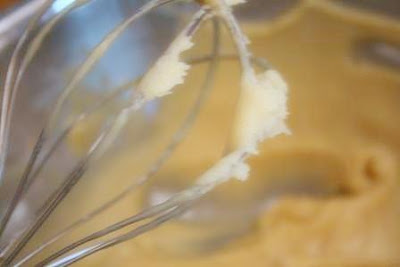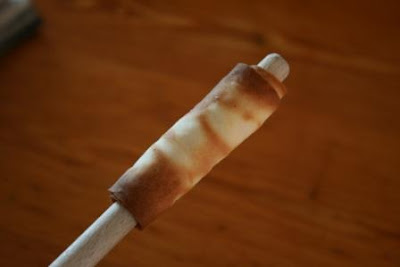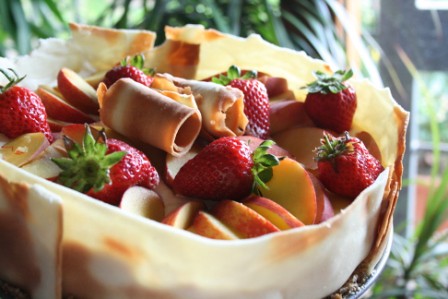







DANISH BRAID
Technique: Making and working with yeasted laminated dough
Recipe: “Danish Braid” from Sherry Yard’s The Secrets of Baking
Why Danish Braid?
• Danish dough is in the family of butter-laminated or layered doughs with puff pastry being the ultimate. Danish dough is sweet and is yeast-leavened, however, where as puff pastry is not.
• The process of making Danish dough is less complex than that of puff pastry, but equally as important to achieve best results, and a great starting place to begin to learn about laminated doughs in general.
• Danish dough is extremely versatile, and once made can be used for a variety of baked goods. The possibilities are endless.
*Since our ever-expanding Daring Bakers group lives in two different hemispheres, the Danish Braid will allow for fillings that are in season in both hemispheres. Hopefully that will assist with cost factors and availability of product.
• I love pastry and have never made Danish pastry before.
When I asked Ben to co-host this month, I suggested several ideas, and the Danish Braid seemed to be the best way for people to have the opportunity to learn, if unfamiliar with laminated doughs, and for those familiar, to be able to maximize choices for ingredients not only in the dough, but the fillings, toppings, and the shape of the braid as well.
Some History:
• According to many sources, “Danish” was born when Danish bakers went on strike, and Viennese bakers were brought in to replace them, creating what is referred to as Vienna Bread.
• Conversely, it is also said that Danish bakers went to Vienna to learn the techniques Viennese bakers employed, and Danish dough was created there.
• In the early 1800’s, C.L. Olsen spent time in Germany, believing in the idea of gaining inspiration from bakers of other countries. He brought knowledge back to Denmark to introduce “foreign” breads to his country, also hiring people of other nationalities to bake in his family bakery.
Why Sherry Yard’s recipe?
• The Secrets of Baking is one of the newer books in my collection, but I’ve had time to try many recipes and am more than satisfied with the results.
• The organization of recipes in the book is built upon the philosophy that if we learn basic techniques, many other recipes come from those techniques. This isn’t new information, but it’s the first time I’ve seen the information organized in such an accessible fashion.
• Her Danish dough recipe included both cardamom and orange, and the combination sounded intriguing.
Guidelines for this Challenge:• Use the recipe as written to make Danish dough and create at least one Danish Braid. The recipe will allow you to make two full braids unless you choose to make only half the dough.
• Fill the Danish Braid with the apple filling provided and/or any other filling as long as it is something you make yourself from scratch.
Choices• Dough ingredients include ground cardamom and orange zest. Cardamom is traditional in Scandinavian breads, but if it is cost prohibitive, or if you have dietary restrictions, by all means, leave it out or replace it with something else. You are welcome to omit the orange zest or choose another type of citrus to flavor your dough.
• The method or style of your braid is your choice. You may vary the width of the dough strips, type of edging, or angle of cuts.
• Often, a glaze, nuts, or sugar are used as toppings. You may choose to use any or all of these, or others you may find interesting.
• Use one or more fillings such as fresh berries, pastry cream, preserves or jams, curds – there are lots of possibilities.
• Once you’ve made a Danish Braid, experiment with Danish pastries with the extra dough.
• If there’s a way to try something savory with the extra dough, then why not?
Terminology:
• Laminated dough – is layered dough created by sandwiching butter between layers of dough
• Detrempe – ball of dough
• Beurrage – butter block
• Turn – each “fold & roll” of the dough produces a single turn in a 3-step process where the dough is folded exactly like a business letter in 3 columns. Each single turn creates 3 layers with this method.
Yard recommends the following:
• Use well-chilled ingredients. This includes flour if your kitchen temperature is above 70 degrees F (~ 21 degrees C).
• It is recommended that long, continuous strokes be used to roll the dough rather than short, jerky strokes to make sure the butter block is evenly distributed.
The 30-minute rest/cooling period for the dough between turns is crucial to re-chill the butter and allow the gluten in the dough to relax.
• Excess flour accumulated on the surface of the dough after turns should be brushed off as pockets of flour can interfere with the rise.
• Yard calls for a “controlled 90 degree F environment” for proofing the constructed braid.
• When making cuts in the dough for the braid, make sure they are not too long and provide a solid base for the filling.•
DANISH DOUGH
Makes 2-1/2 pounds dough
Ingredients
For the dough (Detrempe)
1 ounce fresh yeast or 1 tablespoon active dry yeast
1/2 cup whole milk
1/3 cup sugar
Zest of 1 orange, finely grated
3/4 teaspoon ground cardamom
1-1/2 teaspoons vanilla extract
1/2 vanilla bean, split and scraped
2 large eggs, chilled
1/4 cup fresh orange juice
3-1/4 cups all-purpose flour1 teaspoon
salt
For the butter block (Beurrage)
1/2 pound (2 sticks) cold unsalted butter
1/4 cup all-purpose flour
DOUGH
Combine yeast and milk in the bowl of a mixer fitted with the paddle attachment and mix on low speed. Slowly add sugar, orange zest, cardamom, vanilla extract, vanilla seeds, eggs, and orange juice. Mix well. Change to the dough hook and add the salt with the flour, 1 cup at a time, increasing speed to medium as the flour is incorporated. Knead the dough for about 5 minutes, or until smooth. You may need to add a little more flour if it is sticky. Transfer dough to a lightly floured baking sheet and cover with plastic wrap. Refrigerate for 30 minutes.
Without a standing mixer: Combine yeast and milk in a bowl with a hand mixer on low speed or a whisk. Add sugar, orange zest, cardamom, vanilla extract, vanilla seeds, eggs, and orange juice and mix well. Sift flour and salt on your working surface and make a fountain. Make sure that the “walls” of your fountain are thick and even. Pour the liquid in the middle of the fountain. With your fingertips, mix the liquid and the flour starting from the middle of the fountain, slowly working towards the edges. When the ingredients have been incorporated start kneading the dough with the heel of your hands until it becomes smooth and easy to work with, around 5 to 7 minutes. You might need to add more flour if the dough is sticky.
BUTTER BLOCK
1. Combine butter and flour in the bowl of a mixer fitted with a paddle attachment and beat on medium speed for 1 minute. Scrape down the sides of the bowl and the paddle and then beat for 1 minute more, or until smooth and lump free. Set aside at room temperature.
2. After the detrempe has chilled 30 minutes, turn it out onto a lightly floured surface. Roll the dough into a rectangle approximately 18 x 13 inches and ¼ inch thick. The dough may be sticky, so keep dusting it lightly with flour. Spread the butter evenly over the center and right thirds of the dough. Fold the left edge of the detrempe to the right, covering half of the butter. Fold the right third of the rectangle over the center third. The first turn has now been completed. Mark the dough by poking it with your finger to keep track of your turns, or use a sticky and keep a tally. Place the dough on a baking sheet, wrap it in plastic wrap, and refrigerate for 30 minutes.
3. Place the dough lengthwise on a floured work surface. The open ends should be to your right and left. Roll the dough into another approximately 13 x 18 inch, ¼-inch-thick rectangle. Again, fold the left third of the rectangle over the center third and the right third over the center third. No additional butter will be added as it is already in the dough. The second turn has now been completed. Refrigerate the dough for 30 minutes.
4. Roll out, turn, and refrigerate the dough two more times, for a total of four single turns. Make sure you are keeping track of your turns. Refrigerate the dough after the final turn for at least 5 hours or overnight. The Danish dough is now ready to be used. If you will not be using the dough within 24 hours, freeze it. To do this, roll the dough out to about 1 inch in thickness, wrap tightly in plastic wrap, and freeze. Defrost the dough slowly in the refrigerator for easiest handling. Danish dough will keep in the freezer for up to 1 month.
APPLE FILLING
Makes enough for two braids
Ingredients
4 Fuji or other apples, peeled, cored, and cut into ¼-inch pieces
1/2 cup sugar
1 tsp. ground cinnamon
1/2 vanilla bean, split and scraped
1/4 cup fresh lemon juice
4 tablespoons unsalted butter
Toss all ingredients except butter in a large bowl. Melt the butter in a sauté pan over medium heat until slightly nutty in color, about 6 - 8 minutes. Then add the apple mixture and sauté until apples are softened and caramelized, 10 to 15 minutes. If you’ve chosen Fujis, the apples will be caramelized, but have still retained their shape. Pour the cooked apples onto a baking sheet to cool completely before forming the braid. (If making ahead, cool to room temperature, seal, and refrigerate.) They will cool faster when spread in a thin layer over the surface of the sheet. After they have cooled, the filling can be stored in the refrigerator for up to 3 days. Left over filling can be used as an ice cream topping, for muffins, cheesecake, or other pastries.
DANISH BRAID
Makes enough for 2 large braids
Ingredients
1 recipe Danish Dough (see below)
2 cups apple filling, jam, or preserves (see below)
For the egg wash: 1 large egg, plus 1 large egg yolk
1. Line a baking sheet with a silicone mat or parchment paper. On a lightly floured surface, roll the Danish Dough into a 15 x 20-inch rectangle, ¼ inch thick. If the dough seems elastic and shrinks back when rolled, let it rest for a few minutes, then roll again. Place the dough on the baking sheet.
2. Along one long side of the pastry make parallel, 5-inch-long cuts with a knife or rolling pastry wheel, each about 1 inch apart. Repeat on the opposite side, making sure to line up the cuts with those you’ve already made.
3. Spoon the filling you’ve chosen to fill your braid down the center of the rectangle. Starting with the top and bottom “flaps”, fold the top flap down over the filling to cover. Next, fold the bottom “flap” up to cover filling. This helps keep the braid neat and helps to hold in the filling. Now begin folding the cut side strips of dough over the filling, alternating first left, then right, left, right, until finished. Trim any excess dough and tuck in the ends.Egg WashWhisk together the whole egg and yolk in a bowl and with a pastry brush, lightly coat the braid.
Proofing and Baking
1. Spray cooking oil (Pam…) onto a piece of plastic wrap, and place over the braid. Proof at room temperature or, if possible, in a controlled 90 degree F environment for about 2 hours, or until doubled in volume and light to the touch.
2. Near the end of proofing, preheat oven to 400 degrees F. Position a rack in the center of the oven.
3. Bake for 10 minutes, then rotate the pan so that the side of the braid previously in the back of the oven is now in the front. Lower the oven temperature to 350 degrees F, and bake about 15-20 minutes more, or until golden brown. Cool and serve the braid either still warm from the oven or at room temperature.
The cooled braid can be wrapped airtight and stored in the refrigerator for up to 2 days, or freeze for 1 month.
MY COMMENT
Ok, is my fourth challenge and this is the best one, in my opinion.
As my friend comida de mama says danish braid is
TRULY SCRUMPTIOUS even if technically difficult.
It can be classified in advance technique but as I had my first blog's post on puff pastry it was easier due to past exercises.
The recipe calls for cardamom seeds that I've easily found on an indian shop nearby home, for orange zest I've used dried one of and herbalist shop.
Having three children I haven't much time to spend in my kitchen so on a sunday early morning I've started my challenge.
Opened the fridge and...only an egg so I decided to half ingredients and make only a braid.
Because my children were sleeping when I've started, I've decided to avoid the standing mixer making dough without it and it was really funny and easy.
Laminate the dough was like comb an angry cat...terrible.
I had to fight with my children claiming for a piece of dough (and they stole it) and I used the double turn technique insted the letter fold but unfortunately I've made some little hole in the dough superficial layer so butter escaped, a small amount of course.
My dough rest in the fridge for a longer time (beetween rolling\folding step) because here in Italy was hot enough to melt buttered layer and I've found useful the temperature table even if it was a little bit hard to roll in the first phase of rolling.

As filling I'm in my sabaion period and remembering one of
my first post when I started my blog adventure I use a sabaion cream adding two egg white firmily whipped.
So my filling was fluffy and tried to escape out of braid's holes during cooking time but the final result was perfect, like a mousse fluffy and with a lot of bubbles.
As glaze nothing more simple...ice sugar and some lemon drops.
It was appreciated and my mother-in-law fell in love with it and wasn't enough in her opinion so, for next time, I'll be obliged to do the entire recipe not halved.
But I'll be glad to make it again and this is my personal satisfaction for this challenge.
Finally, I'm sure that my laminated dough technique has been refined and, as my personal challenge, I'm going to ameliorate it using this DB's challenge tips and tricks.
I must make it again and again and again because I was so enthusiastic.
Only the last note, I'm proud because I've used for my shots an old tea-cup of the old granny of my mother in law...in the '800, and I love it.

As usual, thanks to the june's organizers Kelly of
sass and veracity and Ben of
what's cooking? and looking forward the next challenge and...don't forget to have a look to the DB blogroll, it can be easily found on my right side-bar.
And last but not least...this is my filling recipe, stay tuned!
350 ml whole milk
30 g butter
2 egg yolks and 2 firmily whipped egg white
60 g granulated sugar
2 tbs marsala wine
20 g (or 1 tbs) corn starch
warm milk and butter till the butter has been melted into the milk
whip the egg yolks with sugar and gently add the corn starch and the milk-butter mix.
Put the cream into a simmering water bath and cook till it will be creamy like a custard, then add the marsala wine.
Put out of flame and let it cool.
Whip firmly the egg white and add to the cooled cream.
Fill your braid

















































































































































